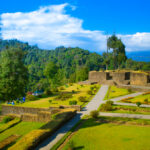Now Reading: Best Places Visiting in Lahaul for Nature, Spirituality & Adventure
-
01
Best Places Visiting in Lahaul for Nature, Spirituality & Adventure
Best Places Visiting in Lahaul for Nature, Spirituality & Adventure
1. Trilokinath Temple

Trilokinath Temple occupies prime position in the peaceful surroundings of Himachal Pradesh as both Hindus and Tibetan Buddhists venerate it as a sacred holy site. Due to its old history combined with outstanding architectural features and cultural value the temple stands today as a permanent monument of religious reverence and communal unity. Visiting Trilokinath Temple grants viewers access to millennium-old traditions alongside peaceful religious harmony between various religious groups.
History
Trilokinath Temple was built from the 9th through the 10th centuries to showcase the history and cultural importance of the region. An inscription from 2002 suggests that Dvanjra Rana built this temple as an ancestor of Rana Thakurs while collaborating with King Sahil Varman of Chamba.
In its construction the temple adopts the Shikher style which highlights stone carvings with beautiful sculptures in addition to ancient inscriptions which tell the story of its historic greatness.
Both Tibetan Buddhists and Hindus regard Trilokinath Temple as a sacred religious site. The temple holds religious importance for Hindus who worship Lord Shiva yet it remains significant for Buddhists because Avalokiteshvara the Bodhisattva of Compassion is associated with it. The temple stands as a spiritual link between two religions since both Hindu and Tibetan Buddhists worship it.
Visitor Information
The spiritual site of Trilokinath Temple allows entry without charging any entrance fees to both devotees and visitors.
Visitors who come to the temple usually need between one and two hours to experience rituals and both the spiritual energy and the entire site.
Visitors prefer to visit Trilokinath Temple within the summer dates from May through September since the climate enables comfortable sightseeing conditions.
Travel Tips
Trilokinath Temple stands as a sacred location so people should choose modest clothing while respecting the traditional customs of the area.
You should bring additional layers since Trilokinath Temple experiences cool temperatures during evening hours and winter season.
The temple requires visitors to respect each ritual and seek permission to photograph the sanctum area.
Bring enough water and pocket-sized snacks with you to maintain hydration levels when touring Trilokinath Temple in the hot summer period.
2. Tabo Monastery

Trilokinath Temple occupies prime position in the peaceful surroundings of Himachal Pradesh as both Hindus and Tibetan Buddhists venerate it as a sacred holy site. Due to its old history combined with outstanding architectural features and cultural value the temple stands today as a permanent monument of religious reverence and communal unity. Visiting Trilokinath Temple grants viewers access to millennium-old traditions alongside peaceful religious harmony between various religious groups.
History
Trilokinath Temple was built from the 9th through the 10th centuries to showcase the history and cultural importance of the region. An inscription from 2002 suggests that Dvanjra Rana built this temple as an ancestor of Rana Thakurs while collaborating with King Sahil Varman of Chamba.
In its construction the temple adopts the Shikher style which highlights stone carvings with beautiful sculptures in addition to ancient inscriptions which tell the story of its historic greatness.
Both Tibetan Buddhists and Hindus regard Trilokinath Temple as a sacred religious site. The temple holds religious importance for Hindus who worship Lord Shiva yet it remains significant for Buddhists because Avalokiteshvara the Bodhisattva of Compassion is associated with it. The temple stands as a spiritual link between two religions since both Hindu and Tibetan Buddhists worship it.
Visitor Information
The spiritual site of Trilokinath Temple allows entry without charging any entrance fees to both devotees and visitors.
Visitors who come to the temple usually need between one and two hours to experience rituals and both the spiritual energy and the entire site.
Visitors prefer to visit Trilokinath Temple within the summer dates from May through September since the climate enables comfortable sightseeing conditions.
Travel Tips
Trilokinath Temple stands as a sacred location so people should choose modest clothing while respecting the traditional customs of the area.
You should bring additional layers since Trilokinath Temple experiences cool temperatures during evening hours and winter season.
The temple requires visitors to respect each ritual and seek permission to photograph the sanctum area.
Bring enough water and pocket-sized snacks with you to maintain hydration levels when touring Trilokinath Temple in the hot summer period.
Related articles : Top 10 Best Places Visiting in Kurukshetra for Spirituality, Heritage & Culture
Stay Informed With the Latest & Most Important News
Previous Post
Next Post
-
 01Top 5 Best Places Visiting in Gyalshing – Monasteries, Lakes & Scenic Escapes
01Top 5 Best Places Visiting in Gyalshing – Monasteries, Lakes & Scenic Escapes -
 02Top 5 Best Places Visiting in Panna – Temples, Waterfalls & Wildlife Escapes
02Top 5 Best Places Visiting in Panna – Temples, Waterfalls & Wildlife Escapes -
 03Top 5 Best Places to Visit in Malerkotla – Malerkotla Fort, Sheesh Mahal & More
03Top 5 Best Places to Visit in Malerkotla – Malerkotla Fort, Sheesh Mahal & More -
 04Top 10 Best Places Visiting in Dakshina Kannad for Culture, Nature & Coastal Charm
04Top 10 Best Places Visiting in Dakshina Kannad for Culture, Nature & Coastal Charm -
 05Top 2 Best Places Visiting in Chitradurga for History, Nature & Adventure
05Top 2 Best Places Visiting in Chitradurga for History, Nature & Adventure -
 06Best Places Visiting in Shopian – Explore Top Attractions & Hidden Gems
06Best Places Visiting in Shopian – Explore Top Attractions & Hidden Gems -
 07Best Places Visiting in Narmadapuram – Temples, Waterfalls & Wildlife Escapes
07Best Places Visiting in Narmadapuram – Temples, Waterfalls & Wildlife Escapes














Pingback: Best Places Visiting in Mahendragarh – Explore Haryana's Hidden Gem